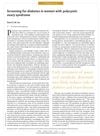Polycystic Ovarian Disease: Current Insights and Therapeutic Strategies
December 2024
in “
African Journal of Biomedical Research
”

TLDR Combining lifestyle changes and medication is most effective for managing PCOS symptoms.
Polycystic Ovarian Syndrome (PCOS) is a complex endocrine disorder affecting women of reproductive age, characterized by symptoms such as anovulation, infertility, obesity, and insulin resistance. The review emphasizes the role of gut microbiota dysbiosis in PCOS pathogenesis and suggests innovative treatments like probiotics, prebiotics, and fecal microbiota transplants. Personalized treatment strategies focus on reducing hyperandrogenic symptoms, inducing ovulation, and managing metabolic comorbidities through lifestyle changes and pharmacological interventions, including oral contraceptives, anti-androgens, insulin sensitizers, and ovulation inducers. Emerging therapies like statins, GLP-1 agonists, inositols, and miRNA therapy show promise in improving metabolic and reproductive outcomes. Comprehensive treatment plans combining lifestyle and medication are more effective in managing PCOS symptoms and associated metabolic issues.

